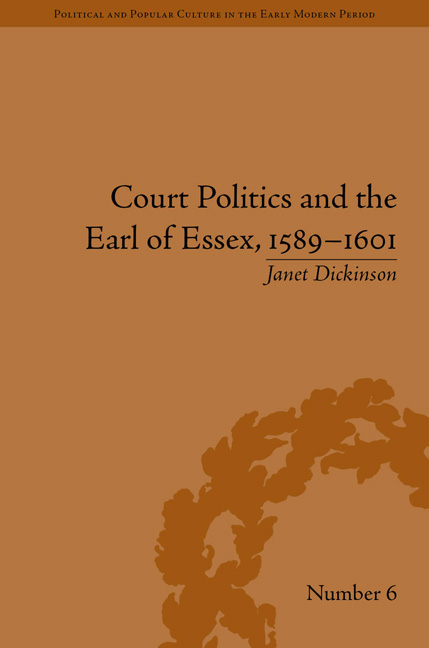Book contents
- Frontmatter
- CONTENTS
- Dedication
- Acknowledgements
- Introduction
- 1 Chivalric Culture and the Earl of Essex
- 2 The Virgin Queen and Her Lovers
- 3 ‘This Late Unhappy Accident’: The Rebellion of 1601
- 4 Faction in the 1590s?
- 5 Essex and Cecil
- 6 Essex and the Essexians
- 7 Elizabeth's Last Decade: Cult or Crisis?
- Notes
- Bibliography
- Index
2 - The Virgin Queen and Her Lovers
- Frontmatter
- CONTENTS
- Dedication
- Acknowledgements
- Introduction
- 1 Chivalric Culture and the Earl of Essex
- 2 The Virgin Queen and Her Lovers
- 3 ‘This Late Unhappy Accident’: The Rebellion of 1601
- 4 Faction in the 1590s?
- 5 Essex and Cecil
- 6 Essex and the Essexians
- 7 Elizabeth's Last Decade: Cult or Crisis?
- Notes
- Bibliography
- Index
Summary
She was strangely attired in a dress of silver cloth, white and crimson, or silver ‘gauze’ as they call it … She kept the front of her dress open, and one could see the whole of her bosom, and passing low, and often she would open the front of this robe with her hands as if she was too hot … Her bosom is somewhat wrinkled … but lower down her flesh is exceeding white and wrinkled, so far as one can see.
As for her face, it is and appears to be very aged. It is long and thin, and her teeth are very yellow and unequal … and on the left side more than the right. Many of them are missing so that one cannot understand her easily when she speaks quickly.
The mercilessly detailed description of the sixty-three year old Elizabeth provided in 1597 by André Hurault de Maisse, the French ambassador, provides what is perhaps the most famous image of the ageing queen. She is, as de Maisse presents her, visibly, obviously, even hideously aged, a caricature of the figure portrayed in contemporary portraits as an eternally youthful beauty. The image corroborates the famous proclamation, issued in 1596, ordering the destruction of all unapproved likenesses of the Queen. And yet, throughout the 1590s, Elizabeth's courtiers – notably her last favourite, Robert Devereux, 2nd Earl of Essex – continued to address her in the most romantic language, as the object of their love and devotion.
- Type
- Chapter
- Information
- Court Politics and the Earl of Essex, 1589–1601 , pp. 25 - 42Publisher: Pickering & ChattoFirst published in: 2014

